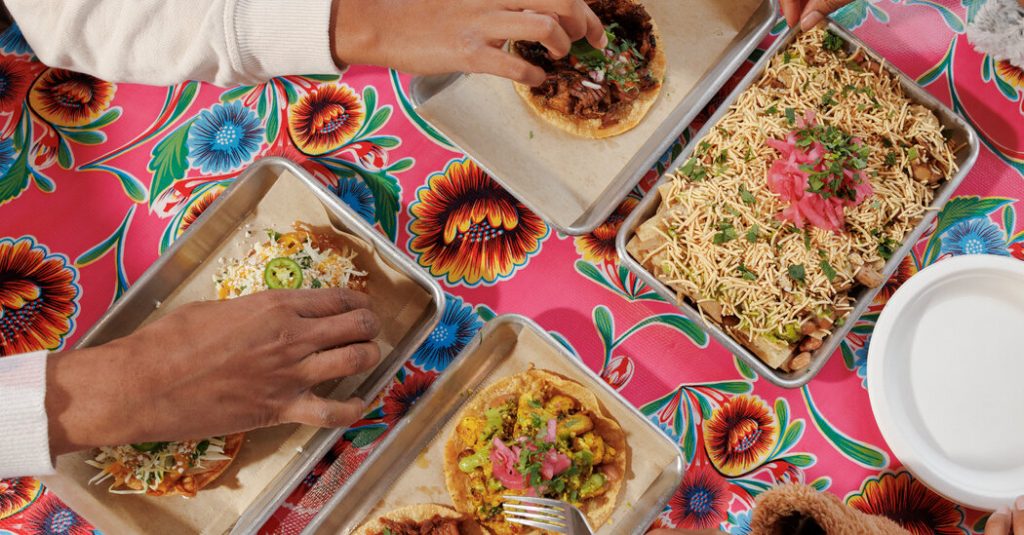Hamachi crudo and its endless, perfunctory variations blur together, but the rendering at Mirra, in Chicago, is a striking thunderbolt of flavor: slices of yellowtail drenched in lime-spiked buttermilk, hot and tangy with a garlic and serrano achar, tucked under a delicate crunch of nopales, ginger and curry leaves.
In one bite, the fresh and drinkable buttermilk, called chaas in Hindi, is invited to party with Sinaloan aguachile, bringing together flavors from India and Mexico into something new, delicious and essentially stateless.
“Is it Indian? Is it Mexican?” Rishi Kumar said on the phone. “No, it’s something else.”
Mr. Kumar and the co-chef Zubair Mohajir opened their restaurant last year in the Bucktown neighborhood, and quickly found the house packed for their energetic and sharply intelligent Mexican Indian cooking.
It’s not unusual to see margaritas crowding tables in the late afternoon as diners share quesadillas shining with melted Amul cheese and rip pastry off their lamb barbacoa biryani. Like the more successful dishes on the menu, the biryani surfaces regional ingredients and techniques without veering toward the formulaic.
Mexican Indian food might sound like a bit of a novelty, orchestrated for a fast-food chain’s viral marketing campaign — it’s not.
The most influential chefs in the genre are Norma Listman and Saqib Keval, who opened their restaurant Masala y Maíz in Mexico City in 2017 and were recently featured on the Netflix series “Chef’s Table.” They reframed the cuisine as “mestizaje,” which can translate to “mixed race,” placing it on a continuum of people and cultures moving and blending together over time — a natural response to displacement and colonization.
It’s a reminder that Mexican Indian cuisine started to emerge a century ago because of restrictive American immigration policies and closed borders.
A small, close-knit Mexican Indian American community formed outside Sacramento when a generation of Punjabi Sikh and Muslim men immigrated from India to find work as farmers and loggers beginning in the late 1800s. After the Immigration Act of 1917 made it near impossible for Indian women to immigrate, hundreds of these men married Mexican women. New kinds of cooking emerged from their idiosyncratic home kitchens and a handful of restaurants the families went on to run.
One couple from this community, Gulam Rasul and Inez Aguirre Rasul, left farming to open El Ranchero in Yuba City, Calif., in 1954. The restaurant served South Asian curries with Spanish rice and flaky parathas, alongside a beef chile verde — Mr. Rasul was Muslim and his restaurant didn’t serve pork. The kitchen also made roti quesadillas with cheese, onions and shredded beef.
Though Mexican Indian food isn’t codified as a cuisine with its own set of classic dishes, that roti quesadilla comes close. It was a hit until El Ranchero closed in the 1990s.
Mr. Mohajir learned about California’s Mexican Indian food during the pandemic. Sitting on the couch with his wife, tumbling down a rabbit hole on his phone as an episode of “Love Is Blind” played in the background, he came across an article published on Eater. He quickly texted Mr. Kumar (“Yo, you know about this?”).
Mr. Kumar, who grew up in Singapore, worked in Mexican kitchens for the chef Rick Bayless and was a devoted student of Mexican regional cuisine. Mr. Mohajir, who was born in Chennai, India, ran a fine-dining pop-up called Coach House. The friends lived in Chicago and in their off hours, inspired in part by Mr. Keval and Ms. Listman, they tested out dishes that blended together their own styles and expertise without any rules but their own.
The resulting food at Mirra is technique-driven and occasionally even fussy, which is to say it doesn’t look one bit like what you’d find at El Ranchero. Still, you can order “Rasul’s roti quesadilla” on their menu, a cheffy version that points back to an overlooked branch of American culinary history.
Early iterations of Mexican Indian food came into being quietly, in the daily negotiations of home kitchens, and still do. Like many immigrant kids, I grew up mixing my own family’s cooking with the other foods around me without thinking too much about how it might be categorized.
My brother and I found tacos and tostadas to be particularly comforting and receptive forms for leftover curries or roasts, chutneys and pickles. I was delighted to find masala potato and jeera chicken tacos, as well as tangy, crispy chaats layered with yellow mayocoba beans, at Saucy Chick in Pasadena, Calif., where peacocks sometimes dodder around the sleepy strip mall parking lot.
The husband-and-wife owners Rhea Patel Michel and Marcel Michel weren’t chefs before they started Saucy Chick. They worked corporate jobs for Disney until they were furloughed during the pandemic. That’s when Mr. Michel invested in a used gas rotisserie that could hold about 16 birds at a time, practicing his skills on an expanding circle of family and friends.
The chicken was marinated to echo jeera chicken, a simple but spectacular curry that Ms. Michel’s Ugandan-Indian father loves to make. Another marinade mimicked the bitter orange and achiote of pibil, Mr. Marcel’s favorite dish growing up in Los Angeles with parents from Jalisco and Colima.
“Two things were converging for us,” she said. “We felt there was a lot in common between our cultures — flavors, hospitality, warmth — and we were looking for accessible meals that would be easy and quick for families.”
The couple took orders through Google forms, and soon popped up at Smorgasburg in Los Angeles, later opening Saucy Chick and Goat Mafia in collaboration with another vendor from the market. And Ms. Michel, who’d rolled roti until her wrists ached, switched to flour and corn tortillas.


